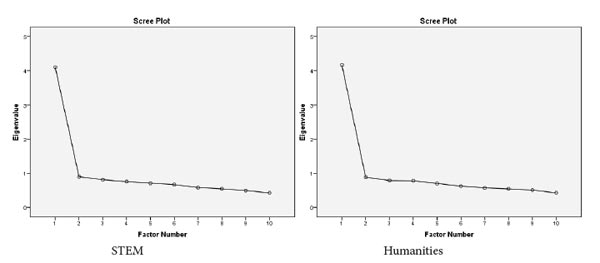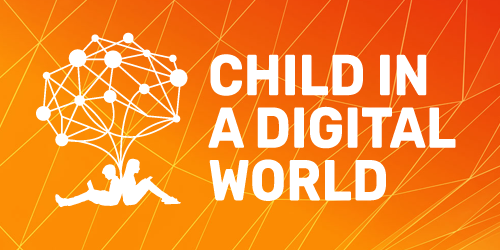Comparing Spatial Ability of Male and Female Students Completing Humanities vs. Technical Degrees
Abstract
Background. Spatial ability (SA) has long been the focus of research in psychology, because it is associated with performance in science, technologies, engineering, and mathematics (STEM). Research has shown that males consistently outperform females in most aspects of SA, which may partially explain the observed overrepresentation of male students seeking STEM degrees.
Objective. This study examines sex and field of study (degree) differences in different aspects of spatial ability and its structure.
Design. We assessed SA by using an on-line gamified battery, which included 10 spatial tests capturing 10 dimensions of spatial ability, among which were mental rotation, spatial visualization, spatial scanning, spatial reasoning, perspective-taking, and mechanical reasoning. The sample consisted of 882 STEM (55% males) and Humanities (20% males) university students in Russia.
Results. Males outperformed females on all assessed components of SA with a small effect size (1–11%). We also found that students from STEM fields outperformed Humanities students on all SA subtests (effect size ranged from 0.2 to 7%). These differences by study choice were not fully explained by the observed over-representation of males in the STEM group. The results of the study suggested no interaction between sex and degree. In other words, on average, males outperformed females, irrespective of whether they were STEM or humanities students; and the STEM advantage was observed for both males and females. The same unifactorial structure of SA was observed in the STEM and Humanities groups.
Conclusion. Our results are consistent with previous research, suggesting sex and study field differences in SA. Longitudinal research is needed to explore the causal mechanisms underscoring these differences.
Received: 25.08.2018
Accepted: 20.10.2018
PDF: http://psychologyinrussia.com/volumes/pdf/2018_4/psych_4_2018_3_Esipenko.pdf
Pages: 37-49
DOI: 10.11621/pir.2018.0403
Keywords: Spatial ability (SA), degree (field of study), gender differences, individual differences, STEM
Introduction
Spatial ability (SA) is the capacity to manipulate mental representations of objects and to understand the relationships between them (Wai, Lubinski & Benbow, 2009, Rimfeld, et al., 2017). It also represents a set of cognitive skills that help people in everyday life. SAs have been linked to a number of life outcomes. For example, better-developed SAs are associated with higher achievements in science, technology, engineering, and mathematics (hereafter identified as STEM) (Uttal et al., 2013, Shakeshaft, 2016).
Research has suggested that spatial ability is a factor separable from general intelligence, but no consensus exists on the exact nature and structure of SA (Harle & Towns, 2011; Shakeshaft, 2016). Several recent studies suggest that SA has mostly a unifactorial structure in adults, i.e., different aspects of SA show high correlation with each other (Rimfeld et al., 2017). However, it remains unclear, whether the observed differentiation among different SA tests results from measurement error or reflects partial construct independence. It is also not clear whether the structure of SA differs as a function of people’s study or occupation. For example, for people whose university degree involves only some spatial tasks, it could be expected that these abilities will form a factor which is separate from other (untrained) aspects of SA.
In line with this hypothesis, research has suggested that spatial abilities may be associated with training in technical specialties, as students with technical degrees have been shown to have better spatial abilities (Rodán, et al., 2016). Initial strengths in SA may influence the choice of the study/professional direction (Kruglik, 2013, Kell, Lubinski, et al., 2013). In turn, STEM education may further develop SA. This is because students in STEM courses deal with spatially relevant material, such as geometry, more often than humanities students (Baenninger & Newcombe, 1989).
For example, chemistry students have been shown to outperform art students in mental rotation (Peters et al., 1995). Part of the explanation for this advantage, may be that chemistry students study molecular geometry, which requires 3D visualization for the construction of molecular structures (Harle & Towns, 2011). The results of a longitudinal study of the spatial abilities of engineering students also support the hypothesis that spatial elements of training can improve spatial abilities. The study showed that the average score of female engineering students on the Purdue Spatial Visualization Test: Rotations (PSVT: R; Guay & McDaniel, 1977) increased over the course of studying for their degree (Sorby & Veurink, 2010).
Another robust group difference in SA is the male advantage: males of all ages consistently outperform females on spatial ability tasks (Pannini et al., 2016; Vuoksimaa et al., 2010; Hirnstein et al., 2014). The effect sizes of the differences vary from modest to moderate across studies, with the largest effect sizes of nearly 1.0 SD shown for 3-D mental rotation tasks (Harle & Towns, 2011, Halpern & Collaer, 2005). For example, in a study of mental rotation, although both sexes improved in spatial ability with age, males outperformed females (ŋp²=.16) at all ages (9-23 years old) (Geiser et al., 2008). This result was replicated in another study of spatial abilities in adults (20-70 years; ŋp²=.13) (Titze et al., 2010).
The observed sex differences in SA may partially explain the disproportion of girls and boys in STEM fields, i.e. the STEM gender gap observed in many countries. Indeed, the percentage of females among STEM graduates ranges from 12.4% in Macao to 40.7% in Algeria; the median is 25.4% (Stoet & Geary, 2018). This underrepresentation is surprising, considering the absence of sex differences in mathematical performance. For example, a recent study has found that 15-year old girls performed similarly or better than boys in science in 67% out of 67 countries participating in the 2015 Program of International Students Assessment (PISA). Another study suggests that in nearly all countries more girls are capable of pursuing college-level STEM study than currently enroll (Stoet & Geary, 2018).
One limitation of most previous studies is that they measured only one or a few aspects of SA. Therefore, there is a lack of understanding as to whether sex and study/occupational differences are present for some or all aspects of spatial ability (Harle & Towns, 2011). More insight is also needed into why differences in spatial ability exist between representatives of different occupations. Existing research suggests that students in STEM fields on average show greater spatial ability than students in Humanities for two reasons: 1) students with higher SA choose to study STEM; and 2) studying STEM improves SA. Exploring the structure of SA in STEM vs. Humanities students can provide new information on this issue.
Objectives
The current study investigates sex and study field differences in SA, using a gamified online test battery, in a sample of STEM and Humanities students. The battery consists of 10 different domains for SA, including 2D and 3D visualization, mental rotation, spatial relations, spatial planning, mechanical reasoning, spatial orientation, and spatial decision making. Based on previous research, we formulated three main hypotheses:
- Men will outperform women on all 10 components of SA, with a small average effect.
- STEM degree students will outperform Humanities degree students, with small average effect. This difference will not be explained solely by sex.
- Both the STEM and Humanities groups will show a unifactorial structure of spatial abilities.
Design
Participants
The data were collected from 882 participants (38% males; mean age=19.69; standard deviation=2.09) attending leading universities in different cities in Russia. The participants were studying for different degrees/occupations: Science, Technology, Engineering, and Mathematics (STEM) disciplines (N=446, 55% males), and Humanities (Hum) (N=406, 20% males). The STEM group included students studying for Technical and Natural science degrees. Additional analyses were performed on the three groups separately (Technical, Natural Sciences, and Humanities). These analyses (available from the authors) revealed that the Natural Sciences and Technical sciences groups produced a very similar pattern of results. Therefore, for the present report, we combined these groups in one STEM group.
Procedure
All participants gave consent for their participation. No reward was given. The data collection was anonymous, with only ID numbers entered into the database. First, participants completed the online spatial test battery called the King’s Challenge (KC). Each item had a time limit. After the time was up, the test automatically switched to the next subtest. The average time for all subtests of the KC battery was approximately one hour. In addition to the KC battery, participants filled in a demographic questionnaire and took a verbal abilities test. This was not time-limited, and took no longer than 20 minutes. The study was approved by the Ethical Committee for Interdisciplinary Investigations, Tomsk State University.
Measures
Demographic questions. Participantscompleted a questionnaire that included demographic questions about their age, sex, university, and city of study, as well as information on the professional degree they were seeking.
Verbal questionnaire “My Vocab”. The “My Vocab” test (Golovin, 2015) was used to assess verbal ability. The baseline design of the test is similar to the Mill Hill Vocabulary Scale (Raven, 1998). Russian vocabulary size was measured using a short version of the test (see Maslennikova et al., 2017). The test estimates the vocabulary of respondents aged 15 to 21 years old. The test consists of 99 test words, comprised of 95 real words and 4 fake words. The latter are included in order to assess whether participants complete the task honestly. This small number of test words allows the measurement of passive vocabulary volume.
We used the total score (the number of words that participants knew the meaning of). Data from participants who marked at least one non-existent word were excluded from the analysis. The resulting distribution showed a negative skew. Therefore, we excluded data from participants whose scores were less than 19. This resulted in a close-to-normal distribution. The verbal test was included in this study in order to assess whether the samples from different universities/cities were comparable.
Spatial ability battery “King’s Challenge”. Spatial ability was tested using an online gamified battery called “King’s Challenge” (Rimfeld et al., 2017). The battery includes 10 spatial tests capturing the major putative dimensions of spatial ability. The 10 subtests are described in Table 1. At the end of the battery, participants received feedback on their performance across the 10 subtests. For additional information about the King’s Challenge battery, see supplementary online information in Rimfeld et al. (2017).
Table 1
Description of the subtests of King’s Challenge battery
|
Subtest name |
N of items |
Time limit per item (sec) |
Description |
|
Cross-sections |
15 |
20 |
visualizing cross-sections of objects |
|
2D drawing |
5 |
45 |
sketching a 2D layout of a 3D object from a specified viewpoint |
|
Pattern assembly |
15 |
20 |
visually combining pieces of objects together to make a whole |
|
Elithorn mazes |
10 |
7 |
joining together as many dots as possible from an array |
|
Mechanical reasoning |
16 |
25 |
multiple-choice naive physics questions |
|
Paper folding |
15 |
20 |
visualizing where the holes are situated after a piece of paper is folded and a hole is punched through it |
|
3D drawing |
7 |
70 |
sketching a 3D drawing from a 2D diagram |
|
Shape rotation |
15 |
20 |
mentally rotating objects |
|
Perspective-taking |
15 |
20 |
visualizing objects from a different perspective |
|
Mazes |
10 |
25 |
searching for a way through a 2D maze in time limited task |
Statistical analysis. ANOVA, exploratory factor analysis and confirmatory factor analysis of the data were conducted using software SPSS 22.0 and JASP 0.8.6.0.
Results
The participants’ vocabulary corresponded to the reported average values of vocabulary of men and women of their age and level of education (Golovin, 2015). We further analyzed the vocabulary to assess the homogeneity of the sample. There were no significant differences in the volume of vocabulary between men and women (F=.79, p=.37, ŋ2 =.002), or field of study (F=4.11, p=.04, ŋ2 =.006). The volume of vocabulary differed significantly among respondents from different cities (F=9.08, p<.001); however, these differences were small (ŋ2 =.066). Details of these analyses are available from the authors.
Tables 2 and 3 present descriptive statistics for each subtest of the “King’s Challenge” (KC) battery, by sex and degree. The variables were standardized over the whole sample. The tables also present the levels of difficulty of the tasks, expressed as a proportion of correct responses.
Sex differences
ANOVA results showed that males significantly outperformed females on all subtests. Effect sizes ranged from .01 (for pattern assembly, paper folding and shape rotation) to .11 (for mechanical reasoning). All comparisons by sex are presented in Table 2. The size of the effect on the total KC score was .05.
Table 2
Results of the analysis of variance by sex for the King’s Challenge (KC) subtests
|
Group |
N |
% of correct responses |
M (SD) |
Levene’s test |
ANOVA |
ŋ² |
|
|
p |
F |
||||||
|
Cross-sections |
male female |
336 564 |
48.5 (25.15) 40.8 (25.37) |
7.29 (3.81) 6.35 (3.55) |
.08 |
13.93*** |
.02 |
|
2D drawing |
male female |
325 545 |
76.8 (21.38) 70.8 (21.32) |
3.84 (1.07) 3.51 (1.09) |
.09 |
19.07*** |
.02 |
|
Pattern assembly |
male female |
331 557 |
45.5 (20.82) 41.0 (19.80) |
6.71 (3.16) 6.15 (2.97) |
.16 |
7.01** |
.01 |
|
Elithorn |
male female |
298 460 |
87.8 (9.43) 82.4 (10.02) |
8.77 (0.95) 8.22 (1.02) |
.07 |
54.08*** |
.07 |
|
Mechanical reasoning |
male female |
330 551 |
68.4 (15.92) 56.6 (15.93) |
10.88 (2.58) 9.03 (2.54) |
.78 |
108.86*** |
.11 |
|
Paper folding |
male female |
329 547 |
57.5 (28.14) 53.0 (28.80) |
8.56 (4.24) 7.93 (4.27) |
.46 |
4.41* |
.01 |
|
3D drawing |
male female |
327 542 |
41.2 (27.70) 33.2 (24.40) |
2.86 (1.94) 2.32 (1.71) |
.00 |
17.69*** |
.02 |
|
Shape rotation |
male female |
327 540 |
50.4 (28.62) 48.5 (26.62) |
8.21 (4.03) 7.48 (4.01) |
.76 |
6.87** |
.01 |
|
Perspective-taking |
male female |
327 539 |
39.6 (30.82) 23.8 (23.55) |
5.84 (4.63) 3.57 (3.54) |
.00 |
66.50*** |
.07 |
|
Mazes |
male female |
327 537 |
57.7 (19.93) 51.9 (20.10) |
5.74 (2.02) 5.13 (2.01) |
.63 |
18.48*** |
.02 |
|
KC Total score |
male female |
327 537 |
54.8 (17.03) 47.1 (15.96) |
67.97 (20.02) 58.90 (18.76) |
.22 |
45.06*** |
.05 |
* p < .05.
** p < .01.
*** p < .001.
Note: KC=King’s Challenge
Levene’s test shows that for most subtests and the total KC score, the variances were homogeneous. The two exceptions were: 3D drawing (rotation and visualization) and perspective-taking (spatial orientation and visualization).
Differences by degree (field of study)
Table 3 presents the comparisons according to the student’s degree of study. Significant differences (p<.001) were found between the STEM and Humanities groups for all subtests and the total score of KC. The size of effect varied from .02 (for pattern assembly) to .10 (total KC score).
Table 3
Analysis of variance by field of study
|
Group |
N |
% of correct responses |
M (SD) |
Levene’s test |
ANOVA |
ŋ² |
ŋ² after control sex |
|||||
|
p |
F |
|||||||||||
|
Cross-sections |
STEM Hum |
453 418 |
49.9 (24.49) 36.7 (25.00) |
7.49 (3.65) 5.89 (3.48) |
.50 |
43.18*** |
.05 |
.03 |
||||
|
2D drawing |
STEM Hum |
445 400 |
78.2 (19.47) 66.9 (22.29) |
3.91 (.97) 3.33 (1.11) |
.00 |
64.44*** |
.08 |
.05 |
||||
|
Pattern assembly |
STEM Hum |
447 413 |
45.2 (20.73) 39.7 (19.36) |
6.77 (3.11) 6.00 (2.89) |
.17 |
13.88*** |
.02 |
.01 |
||||
|
Elithorn |
STEM Hum |
401 335 |
85.8 (10.09) 83.1 (10.01) |
8.58 (1.00) 8.31 (.10) |
.65 |
13.39*** |
.02 |
.002 |
||||
|
Mechanical reasoning |
STEM Hum |
442 411 |
65.0 (16.66) 56.6 (16.08) |
10.41 (2.66) 9.03(2.56) |
.16 |
59.01*** |
.07 |
.02 |
||||
|
Paper folding |
STEM Hum |
439 409 |
60.7 (28.08) 48.0 (27.73) |
9.08 (4.22) 7.21 (4.11) |
.54 |
42.53*** |
.05 |
.04 |
||||
|
3D drawing |
STEM Hum |
435 407 |
43.9 (26.37) 27.5 (22.62) |
3.07 (1.85) 1.94 (1.60) |
.00 |
90.05*** |
.08 |
.07 |
||||
|
Shape rotation |
STEM Hum |
435 405 |
53.8 (29.15) 46.9 (26.12) |
8.40 (4.03) 7.03 (3.93) |
.63 |
24.80*** |
.03 |
.002 |
||||
|
Perspective-taking |
STEM Hum |
435 404 |
36.1 (29.39) 22.2 (23,69) |
5.44 (4.40) 3.43 (3.61) |
.00 |
51.84*** |
.06 |
.02 |
||||
|
Mazes |
STEM Hum |
434 403 |
57.3 (19.00) 50.6 (21.00) |
5.71 (1.90) 5.02 (2.10) |
.06 |
24.34*** |
.03 |
.01 |
||||
|
KC Total score |
STEM Hum |
434 403 |
55.1 (15.96) 45.6 (14.96) |
68.33 (19.03) 56.22 (18.38) |
.45 |
87.40*** |
.10 |
.06 |
||||
* p < .05.
** p < .01.
*** p < .001.
Note: STEM=STEM degree; Hum=Humanities degree; KC=King’s Challenge
Levene’s test showed homogeneous variances for all tests except 2D, 3D, and perspective-taking.
After controlling for sex, the effect sizes for some of the tests were significantly reduced, such as for mechanical reasoning (from .07 to .02) and perspective-taking (from .06 to .02). However, for other tests (2D, 3D, and total score), this change was less pronounced.
Sex by Study field (degree) Interaction
We performed a 2 (STEM versus Humanities) x 2 (male versus female) ANOVA (See Table 4). The results revealed a major effect of sex (F=14.57, p<.00, ŋ²=.016); and a main effect of degree (F=49.02, p<.001, ŋ²=.06). The contribution of the degree was greater than the contribution of sex. No interaction was found between sex and degree (F=.01, p<.94, ŋ²=.00).
Table 4
2x2 ANOVA assessing the effect of sex and degree with interaction between the 2 factors
|
Cases |
Sum of Squares |
Degrees of freedom |
Mean squares |
F statistic |
p value |
ŋ² |
|
Degree |
16914.17 |
1 |
16914.17 |
49.02 |
<.001 |
.06 |
|
Sex |
5028.66 |
1 |
5028.66 |
14.57 |
<.001 |
.02 |
|
Degree*Sex |
2.696 |
1 |
2.70 |
.01 |
.94 |
.00 |
|
Residual |
287422.80 |
833.00 |
345.05 |
|
Number of observations = 837; R2=.11; adjusted R2=.108.
Factor analysis
First, we tested the 10 variables using both the Kaiser-Meyer-Olkin (KMO) measure of sampling adequacy (MSA) and Bartlett’s test of sphericity. For the STEM group, the KMO value was .90 and the chi-square value was 1007.79 (p<.001). For the Humanities group, the KMO value was .91 and chi-square value was 848.86 (p<.001). These indicated that the data could be used with factor analysis (Hair et al.,1998).
We determined the number of factors using an eigenvalue of more than one. For the STEM group, one factor (eigenvalue 4.10) explained 41.01 % of the variance. For the Humanities group, one factor (eigenvalue 4.16) explained 41.65% of the variance (see Table 5).
Examination of the scree plots (Fig.1) revealed an obvious “elbow” after the first factor. The results of the factor analysis show that the STEM and Humanities groups have similar unifactorial structures of spatial abilities.

Figure 1. Scree Plots illustrating the factor structure of spatial abilities (Left panel: STEM sample; Right panel: Humanities sample).
Table 5
Factor analysis
|
|
STEM |
Humanities |
|
|
Factor |
Factor |
||
|
1 |
1 |
||
|
3D drawing |
.73 |
.73 |
|
|
Paper folding |
.67 |
.69 |
|
|
Cross-sections |
.65 |
.67 |
|
|
2D drawing |
.64 |
.61 |
|
|
Shape rotation |
.63 |
.60 |
|
|
Mechanical reasoning |
.58 |
.60 |
|
|
Perspective-taking |
.55 |
.57 |
|
|
Pattern assembly |
.51 |
.52 |
|
|
Mazes |
.47 |
.48 |
|
|
Elithorn |
.40 |
.43 |
Discussion
The results show that our first hypothesis was supported. Males on average outperformed females in all spatial tasks, with effect sizes ranging from .02 to .11. These results are consistent with previous studies, demonstrating male advantage in SA in adults, with similar effect sizes (Titze et al., 2010; Linn & Petersen, 1985). As in previous studies, the largest differences were observed in tasks that required understanding of everyday physics, and the ability to make a fast decision about trajectory (mechanical reasoning and Elithorn mazes subtests). The better performance by males on these tasks is in line with the hypothesis that boys have greater experience with certain tasks that promote greater development of spatial cognition, such as activities that involve eye-hand coordination, estimating trajectories of moving objects, or moving about within a complex spatial configuration (Cherney, 2010).
Surprisingly, mental rotation (shape rotation subtest) showed small sex differences in this study (.2). Previous research showed a greater effect size (.5-.9) for this ability (Linn & Petersen, 1985; Parsons, 2004). This difference may be due to the differences in the tasks presented. The 2D figure with four different pieces inside which we used in our study may require somewhat different processing than figures of the Vandenberg Mental Rotations task, often used in previous studies. In the present study, the details which could be markers for rotation were obvious, and rotation required only left/right axis; this is different from when stimuli require rotation along both the top/bottom axis and the left/right axis (Peters et al., 1995). However, the small effect size is unlikely to be explained by the reduced difficulty of the task. As shown by the proportion of correct responses, the task was difficult (approximately 50% correct responses). In addition, there was no correspondence between the difficulty of the tasks and the effect size.
Our second hypothesis was also confirmed. The STEM group outperformed the Humanities group in all SA subtests and the total score (effect size ranged from .002 to .7). The biggest advantage of STEM degree students was observed for 2D and 3D drawing, as well as on the KC total score (5-7%). The observed differences between degrees (fields of study), such as in 3D drawing, may be partly explained by the STEM students’ extensive use of computer technologies, such as software for design and simulation, which often use 3D manipulation of objects (Metz, et al., 2012; Sorby & Veurink, 2010).
The results of the study suggested no interaction between sex and degree. In other words, males on average outperformed females, irrespective of whether they were STEM or Humanities students; and the STEM advantage was observed for both males and females. Moreover, the field of study differences were not fully explained by the over-representation of males in the STEM group. The differences between the two degrees were reduced but did not disappear after correcting for sex.
The reasons for over-representation of men in STEM and of women in humanities which was observed in this study, remain poorly understood, and may include gender stereotypes regarding educational choices (Ramaci, et al., 2017). The STEM gender gap may also emerge partly because students select their field of study based on their evaluation of their intra-individual strengths and weaknesses, irrespective of their objective ability (e.g., Stoet & Geary, 2018). According to previous research on common educational practice, students tend to select their area of study based on an evaluation of their intra-individual strengths and weaknesses (e.g., Gardner, 2016). Research has shown that in a majority of the countries studied, boys, on average, performed better in math (100% of countries) and science (97% of countries) than in reading. By contrast, girls, on average, showed higher performance in reading than in math and science in all countries (Stoet & Geary, 2015).
Finally, our study’s third hypothesis was also confirmed. Despite average differences in performance, the structure of spatial abilities for STEM and Humanities groups was very similar. For both groups, one factor explained a very similar proportion of the overall variance (41 and 42%) and showed a unifactorial structure of SA. This result suggests that, if pursuing STEM education has an influence on SA, this influence is global, affecting all aspects of SA rather than a sub-set of practiced skills. An alternative explanation is that the SA advantage shown by STEM students, partly accounts for why they are pursuing STEM, rather than resulting from their practice while studying for their degree. Longitudinal research is needed to further investigate these alternative explanations.
Conclusion
This investigation explored the spatial ability of male and female students completing Humanities and STEM university degrees. Males on average performed better on spatial tasks than females. STEM students outperformed Humanity students in all SA tasks, and these differences weren’t completely explained by the over-representation of males in the STEM group. There was no statistical interaction between sex and field of study. Both groups had a unifactorial structure of spatial abilities. Longitudinal research is needed for a better understanding of the processes underlying the group differences we observed.
Limitations
This study had a number of limitations. First, the homogeneity of the sample was measured by a short verbal ability test, rather than a measure of general cognitive ability. Second, the results showed heterogeneity of variance on a number of subtests, which may indicate task-specific technical issues. Third, the study was not longitudinal and did not allow for evaluating whether studying for a STEM degree can enhance SA.
Acknowledgements
This work was supported by the Russian Ministry for Education and Science project № 25.8905.2017/9.10.
References
Baenninger, M. & Newcombe, N. (1989). The role of experience in spatial test performance: A meta-analysis. Sex roles, 20(5-6), 327-344. https://doi.org/10.1007/BF00287729
Cherney, I.D. & Voyer, D. (2010). Development of a Spatial Activity Questionnaire I: Items Identification. Sex Roles, 62(1-2), 89-99. https://doi.org/10.1007/s11199-009-9710-9
Gardner, A. (2016). How important are GCSE choices when it comes to university? London, UK: Which? Retrieved from http://university.which.co.uk/advice/gcse-choices-university/how-important-are-gcse-choices-when-it-comes-to-university.
Geiser, C., Lehmann, W., & Eid, M. (2008). A note on sex differences in mental rotation in different age groups. Intelligence, 36(6), 556-563. https://doi.org/10.1016/j.intell.2007.12.003
Golovin, G.V. (2015). Izmerenie passivnogo slovarnogo zapasa russkogo yazyka [Receptive vocabulary size measurement for Russian language]. Socio- i psiholingvisticheskie issledovaniya [Socio-Psycholinguistic Research], 3, 148-159.
Guay, R.B. & McDaniel, E.D. (1977). The relationship between mathematics achievement and spatial abilities among elementary school children. Journal for Research in Mathematics Education, 8(3), 211-215. https://doi.org/10.2307/748522
Hair, J.F., Anderson, R.E., Tatham, R.L., & Black, W.C. (1998). Multivariate data analysis. Upper Saddle River.
Halpern, D.F., & Collaer, M.L. (2005). Sex differences in visuospatial abilities: More than meets the eye. In P. Shah & A. Miake (Eds.), The Cambridge Handbook of Visuospatial Thinking (pp. 170–212). New York: Cambridge University Press.
Harle, M. & Towns, M. (2011). A Review of Spatial Ability Literature, Its Connection to Chemistry, and Implications for Instruction. Journal of Chemical Education, 88(3), 351-360. https://doi.org/10.1021/ed900003n.
Hirnstein, M., Andrews, L.C., & Hausmann, M. (2014). Gender-Stereotyping and Cognitive Sex Differences in Mixed- and Same-Sex Groups. Archives of Sexual Behavior, 43(8), 1663-1673. https://doi.org/10.1007/s10508-014-0311-5
Kell, H.J., Lubinski, D., Benbow, C.P., & Steiger, J.H. (2013). Creativity and technical innovation: Spatial ability’s unique role. Psychological science, 24(9), 1831-1836. https://doi.org/10.1177/0956797613478615
Kruglik, A.V. (2013). Prostranstvennyy faktor v strukture intellektual'nykh sposobnostey uchashchikhsya [Spatial factor in students’ intellectual abilities structure]. Psikhologicheskii zhurnal [Psychological journal], 1-2, 112-116. Retrieved from http://elib.bsu.by/handle/123456789/106262
Linn, M.C. & Petersen, A.C. (1985). Emergence and characterization of sex differences in spatial ability: A meta-analysis. Child development, 56(6), 1479-1498. https://doi.org/10.2307/1130467
Maslennikova, E.P., et al. (2017). Slovarnyi zapas, kak pokazatel' verbal'nogo intellekta: primenenie ekspress-metodiki otsenki slovarnogo zapasa [Vocabulary Size as a Verbal Intelligence Index: Application of the Express Methods of Estimating Vocabulary Size]. Vestnik yuzhno-ural'skogo gosudarstvennogo universiteta. Seriya Psikhologiya [Bulletin of the South Ural State University. Ser. Psychology], 10(3), 63-69. https://doi.org/10.14529/psy170306
Metz, S.S., Donohue, S., & Moore, C. (2012). Spatial skills: A focus on gender and engineering. International Journal of Science Education, 31, 1-8.
Pannini, G. et al. (2016). Testing the Testosterone Transmission Hypothesis: An Investigation of Twin Performance On Spatial Ability Tasks. Intelligence Research (ISIR). Abstracts, 87.
Parsons, T.D., Larson, P., Kratz, K., Thiebaux, M., Bluestein, B., Buckwalter, J.G., & Rizzo, A.A. (2004). Sex differences in mental rotation and spatial rotation in a virtual environment. Neuropsychologia, 42(4), 555-562. https://doi.org/10.1016/j.neuropsychologia.2003.08.014
Peters, M., Laeng, B., Latham, K., Jackson, M., Zaiyouna, R., & Richardson, C. (1995). A redrawn Vandenberg and Kuse mental rotations test: different versions and factors that affect performance. Brain and cognition, 28(1), 39-58. https://doi.org/10.1006/brcg.1995.1032
Ramaci, T., Pellerone, M., Ledda, C., Presti, G., Squatrito, V., & Rapisarda, V. (2017). Gender stereotypes in occupational choice: a cross-sectional study on a group of Italian adolescents. Psychology Research and Behavior Management, 10, 109-117. https://doi.org/10.2147/PRBM.S134132
Rimfeld, K., Shakeshaft, N.G., Malanchini, M., Rodic, M., Selzam, S., Schofield, K., & Plomin, R. (2017). Phenotypic and genetic evidence for a unifactorial structure of spatial abilities. The Proceedings of the National Academy of Sciences in the United States of America, 114(10), 2777-2782. https://doi.org/10.1073/pnas.1607883114
Rodán, A., Contreras, M.J., Elosúa, M.R., & Gimeno, P. (2016). Experimental but Not Sex Differences of a Mental Rotation Training Program on Adolescents. Fronters in Psychology, 7, 1050. https://doi.org/10.3389/fpsyg.2016.01050.
Sakamoto, M. & Spiers, M.V. (2014). Sex and cultural differences in spatial performance between Japanese and North Americans. Archives of Sexual Behavior, 43(3), 483-491. https://doi.org/10.1007/s10508-013-0232-8
Shakeshaft, N.G., Rimfeld, K., Schofield, K.L., Selzam, S., Malanchini, M., Rodic, M., & Plomin, R. (2016). Rotation is visualisation, 3D is 2D: using a novel measure to investigate the genetics of spatial ability. Scientific reports, 6, 30545. https://doi.org/10.1038/srep30545
Sorby, S. & Veurink, N. (2010). Are The Visualization Skills Of First Year Engineering Students Changing? Paper presented at 2010 Annual Conference & Exposition, Louisville, Kentucky. Retrieved from https://peer.asee.org/16026
Stoet, G. & Geary, D.C. (2015). Sex differences in academic achievement are not related to political, economic, or social equality. Intelligence, 48, 137–151. https://doi.org/10.1016/j.intell.2014.11.006.
Stoet, G. & Geary, D.C. (2018). The gender-equality paradox in science, technology, engineering, and mathematics education. Psychological science, 29(4), 581-593. https://doi.org/10.1177/0956797617741719
Titze, C., Jansen, P., & Heil, M. (2010). Mental rotation performance and the effect of gender in fourth graders and adults. European Journal of Developmental Psychology, 7(4), 432-444. https://doi.org/10.1080/17405620802548214
Uttal, D.H., Meadow, N.G., Tipton, E., Hand, L.L., Alden, A.R., Warren, C., & Newcombe, N. S. (2013). The malleability of spatial skills: A meta-analysis of training studies. Psychological bulletin, 139, 352-402. https://doi.org/10.1037/a0028446
Vuoksimaa, E., Kaprio, J., Kremen, W.S., Hokkanen, L., Viken, R.J., Tuulio-Henriksson, A., & Rose, R.J. (2010). Having a Male Co-Twin Masculinizes Mental Rotation Performance in Females. Psychological Science, 21(8), 1069-1071.https://doi.org/10.1177/0956797610376075
Wai, J., Lubinski, D., & Benbow, C.P. (2009). Spatial ability for STEM domains: Aligning over 50 years of cumulative psychological knowledge solidifies its importance. Journal of Educational Psychology, 101(4), 817-835. https://doi.org/10.1037/a0016127To cite this article: Esipenko E.A., et. al. (2018). Comparing Spatial Ability of Male and Female Students Completing Humanities vs. Technical Degrees. Psychology in Russia: State of the Art, 11 (4), 37-49
The journal content is licensed with CC BY-NC “Attribution-NonCommercial” Creative Commons license.










